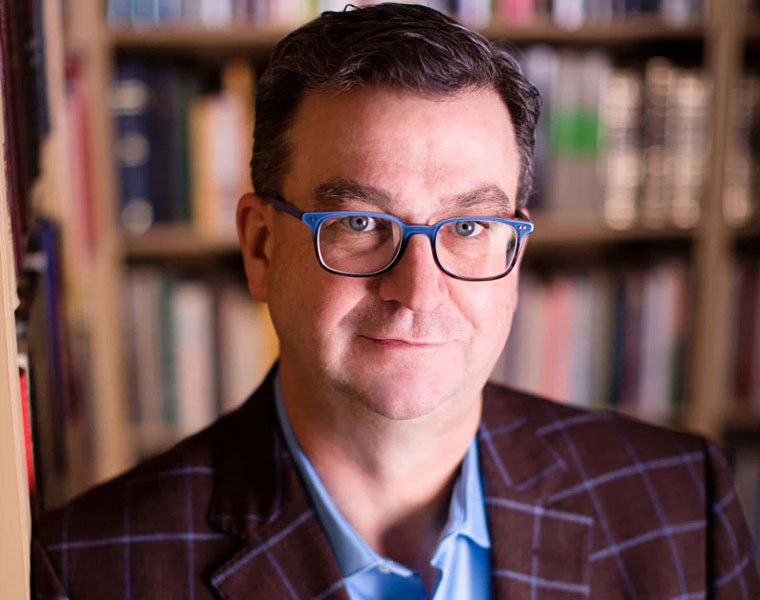If you look up the definition of “book lover,” you may find Jim Gilmore’s name listed.
The shelves in his office at Weatherhead School of Management are overflowing with books. And though you might expect to find primarily business-focused publications among them given Gilmore’s role as an associate professor in the Department of Design and Innovation, one quick look would prove you wrong.
“I’m a very eclectic reader,” he said.
In a matter of seconds, Gilmore can pull any one of the hundred books off his shelves, give you a thorough overview of its contents and point to his favorite page.
In honor of National Book Lovers Day (Aug. 9), we sat down with Gilmore to learn more about his passion for reading and how that lends itself to his work as an author.
Where it all started
Like many literature aficionados, Gilmore’s love of books stems back to his childhood. His father was an English professor and always kept books around the house. When Gilmore’s father passed away, he inherited many of them—around 5,000, to be exact.
It wasn’t until Gilmore was an undergraduate student at The Wharton School of the University of Pennsylvania that he became a regular reader himself. “College set me ablaze on reading,” he said.
As a young avid reader, Gilmore said he never “had the aspiration” to publish a book himself, but that notion wouldn’t hold true.
Becoming an author
Over the years, Gilmore learned how to combine his passions for reading and business by putting pen to paper. To date, he has authored three books and has many more ideas on future ones to be written.
He tried his hand at writing for the first time when penning articles for trade publications at his consulting job with Cleveland Consulting Associates, an experience that introduced him to a book titled Mass Customization: The New Frontier in Business Competition by Joseph Pine. Gilmore was interested in Pine’s use of the phrase “mass customization,” so he wrote the author a letter and, when they met, they “hit it off.” Gilmore hired Pine to work for the consulting practice and then wrote his first article for the Harvard Business Review (HBR) with Pine as a collaborator.
“I had the luxury of working with someone who already published with HBR, so I never had to break through with them,” Gilmore said.
The first book Gilmore co-authored with Pine was The Experience Economy: Competing for Customer Time, Attention, and Money, published in 1999 with the Harvard Business Review Press.
The idea for the book came from a single word, “experience,” which Gilmore took and turned into the “experience economy.” The book explores how companies excel by offering compelling experiences for their customers, resulting not only in increased customer allegiance but also in more profitable bottom lines.
The Experience Economy has gone on to be a major success, winning awards, being published in 19 languages, and being rereleased with new prefaces and models a couple of times—with the most recent release in 2019.
“It was wildly successful,” Gilmore said. “I’m humbled by it.”
The idea for Gilmore and Pine’s second book emerged from speaking on the topic of businesses creating experiences for their customers, as Best Buy does with its “Geek Squad” or Mexican restaurants do through themes like “Taco Tuesday” to appeal to customers.
“So often the reaction we’d get from people is, ‘that seems so fake,’” Gilmore said.
Gilmore and Pine co-authored Authenticity: What Consumers Really Want in 2007 with the Harvard Business Review Press. In the book, they argued that to trounce rivals, companies must grasp, manage and excel at rendering authenticity.
For Gilmore’s third book, he was inspired by Edward de Bono’s Six Thinking Hats method. In Look: A Practical Guide for Improving Your Observational Skills, published in 2016 with the Greenleaf Book Group, Gilmore introduced the metaphor of ”six looking glasses.” Each looking glass represents a particular skill to master in order to enhance the way we look at the world.
Tips for reading and writing
As an associate professor, one of Gilmore’s goals in his courses is to create readers.
One exercise he’s done with his undergraduate students to help them find books they’re interested in reading is to use the alphabet as a thinking tool. “For every letter in the alphabet, name one thing you’re curious about and then read a book on it,” he said. “A for architecture, B for baseball, and on and on.”
Another idea, Gilmore said, is to look at book reviews in The New York Times and The Wall Street Journal. “This can help you find what to read or what not to read,” he explained.
And if you have a desire to learn how to write? Gilmore offers one simple tip: “If you want to write, read.”

